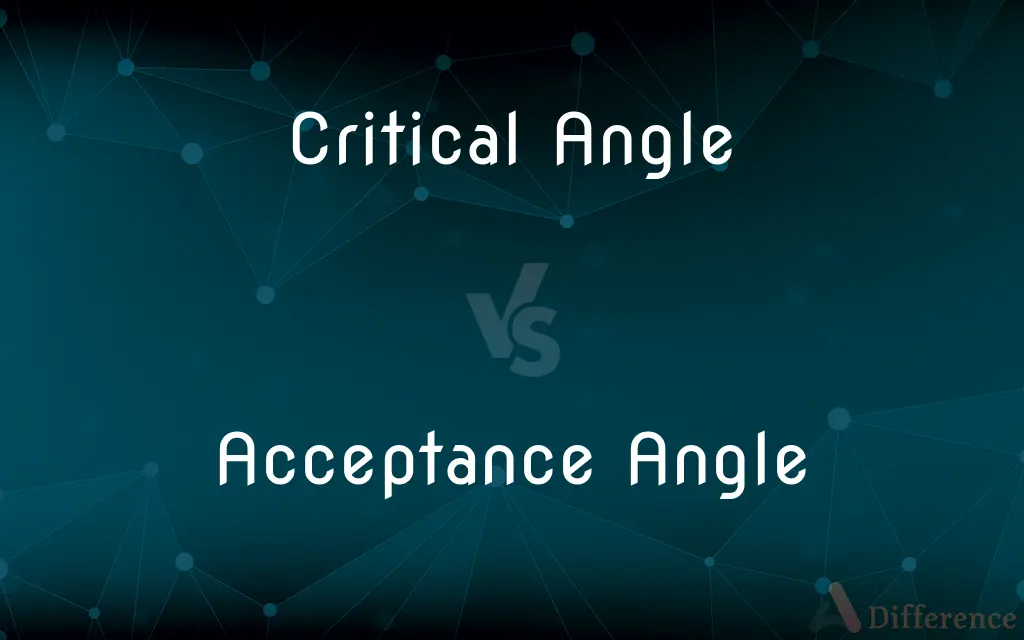Critical Angle vs. Acceptance Angle — What's the Difference?
By Tayyaba Rehman — Published on January 2, 2024
Critical Angle is the minimum angle of incidence for total internal reflection, while Acceptance Angle is the maximum angle at which light can enter a fiber to propagate.

Difference Between Critical Angle and Acceptance Angle
Table of Contents
ADVERTISEMENT
Key Differences
The critical angle is a concept in optics that refers to the minimum angle of incidence at which light is totally internally reflected within a medium, like glass or water. The acceptance angle, on the other hand, is specific to fiber optics and refers to the maximum angle at which light can enter an optical fiber to be effectively guided along it.
The critical angle occurs when light passes from a medium with a higher refractive index to a lower one, leading to total internal reflection at and beyond this angle. In contrast, the acceptance angle determines the range of angles over which an optical fiber can accept light for efficient transmission, influenced by the refractive indices of the core and cladding.
In terms of application, the critical angle is crucial in understanding phenomena like mirages and the functioning of periscopes. The acceptance angle is key to the efficiency of fiber optic cables used in telecommunications and medical imaging.
The critical angle is determined by the refractive indices of the two media involved in light transmission. The acceptance angle, however, also considers the fiber's numerical aperture, a measure of its ability to gather light.
In summary, while the critical angle deals with the reflection of light within a medium, the acceptance angle is concerned with the transmission of light through a fiber optic cable.
ADVERTISEMENT
Comparison Chart
Definition
Minimum angle for total internal reflection.
Maximum angle for light to enter fiber optics.
Dependence
Refractive indices of two media.
Refractive indices and numerical aperture of fiber.
Phenomenon
Reflection within a medium.
Transmission through optical fiber.
Key Importance
In understanding optical phenomena.
In efficiency of fiber optic communications.
Measurement Focus
Angle of incidence for reflection.
Angle of light entry for optimal transmission.
Compare with Definitions
Critical Angle
Determined by the refractive indices of the two media.
The critical angle changes with the refractive index of the mediums involved.
Acceptance Angle
Key in designing efficient fiber optic communication systems.
The acceptance angle is crucial for maximizing data transmission in fiber optics
Critical Angle
A threshold angle for total internal reflection.
When the incidence angle exceeded the critical angle, no light escaped the medium.
Acceptance Angle
Acceptance angle is the maximum angle at which light can enter a fiber to propagate.
The fiber's efficiency depends on light entering within the acceptance angle.
Critical Angle
Critical for understanding phenomena like fiber optics and mirages.
The concept of the critical angle helps explain how fiber optic cables work.
Acceptance Angle
Influences the amount of light that can be captured by optical fibers.
A wider acceptance angle allows more light to be transmitted through the fiber.
Critical Angle
The critical angle is the angle of incidence beyond which total internal reflection occurs.
At the critical angle, the light beam completely reflected inside the water, creating a mirror-like effect.
Acceptance Angle
Determined by the fiber's numerical aperture and refractive indices.
We optimized the acceptance angle by adjusting the fiber's numerical aperture.
Critical Angle
It applies when light passes from a denser to a rarer medium.
We calculated the critical angle for light transitioning from glass to air.
Common Curiosities
How is the acceptance angle defined in fiber optics?
The acceptance angle is the maximum angle at which light can enter an optical fiber to be effectively guided along it.
What determines the critical angle?
The critical angle is determined by the refractive indices of the two media at the interface where light is incident.
Can the critical angle be observed in everyday life?
Yes, phenomena like the shining of a diamond or the mirage effect are examples of the critical angle in action.
Does the acceptance angle depend on the fiber's properties?
Yes, the acceptance angle depends on the numerical aperture and the refractive indices of the fiber's core and cladding.
What is the critical angle in optics?
The critical angle is the minimum angle of incidence at which light completely reflects internally within a medium, without refracting into a less dense medium.
Why is the acceptance angle important in fiber optics?
The acceptance angle is crucial for maximizing the amount of light that enters and is transmitted by an optical fiber, affecting the efficiency of fiber optic communication.
Does the acceptance angle vary between different types of optical fibers?
Yes, different optical fibers can have varying acceptance angles based on their construction and the materials used.
How does the acceptance angle affect data transmission in fiber optics?
A wider acceptance angle allows more light to enter the fiber, potentially enhancing data transmission efficiency and bandwidth.
Can the critical angle be changed?
The critical angle can change if the refractive indices of the interacting media are altered.
Is the critical angle always the same for a given material?
The critical angle can vary based on the material's refractive index and the medium it's interfacing with.
What happens when light hits at the critical angle?
At the critical angle, light is totally internally reflected, with none of the light refracting into the less dense medium.
How does light behave outside the acceptance angle in fiber optics?
Light entering at an angle greater than the acceptance angle won't be efficiently guided and will be lost, reducing the fiber's transmission efficiency.
Are critical angle and acceptance angle concepts used in designing optical devices?
Yes, understanding these angles is essential in designing various optical devices, including lenses, prisms, and fiber optic cables.
What role does the numerical aperture play in determining the acceptance angle?
The numerical aperture, which measures the fiber's ability to gather light, directly influences the size of the acceptance angle.
What is total internal reflection in relation to the critical angle?
Total internal reflection is the phenomenon where all the incident light is reflected back into the medium, occurring when the angle of incidence exceeds the critical angle.
Share Your Discovery

Previous Comparison
Supercomputer Computer vs. Mainframe Computer
Next Comparison
Sims FreePlay vs. Sims MobileAuthor Spotlight
Written by
Tayyaba RehmanTayyaba Rehman is a distinguished writer, currently serving as a primary contributor to askdifference.com. As a researcher in semantics and etymology, Tayyaba's passion for the complexity of languages and their distinctions has found a perfect home on the platform. Tayyaba delves into the intricacies of language, distinguishing between commonly confused words and phrases, thereby providing clarity for readers worldwide.













































